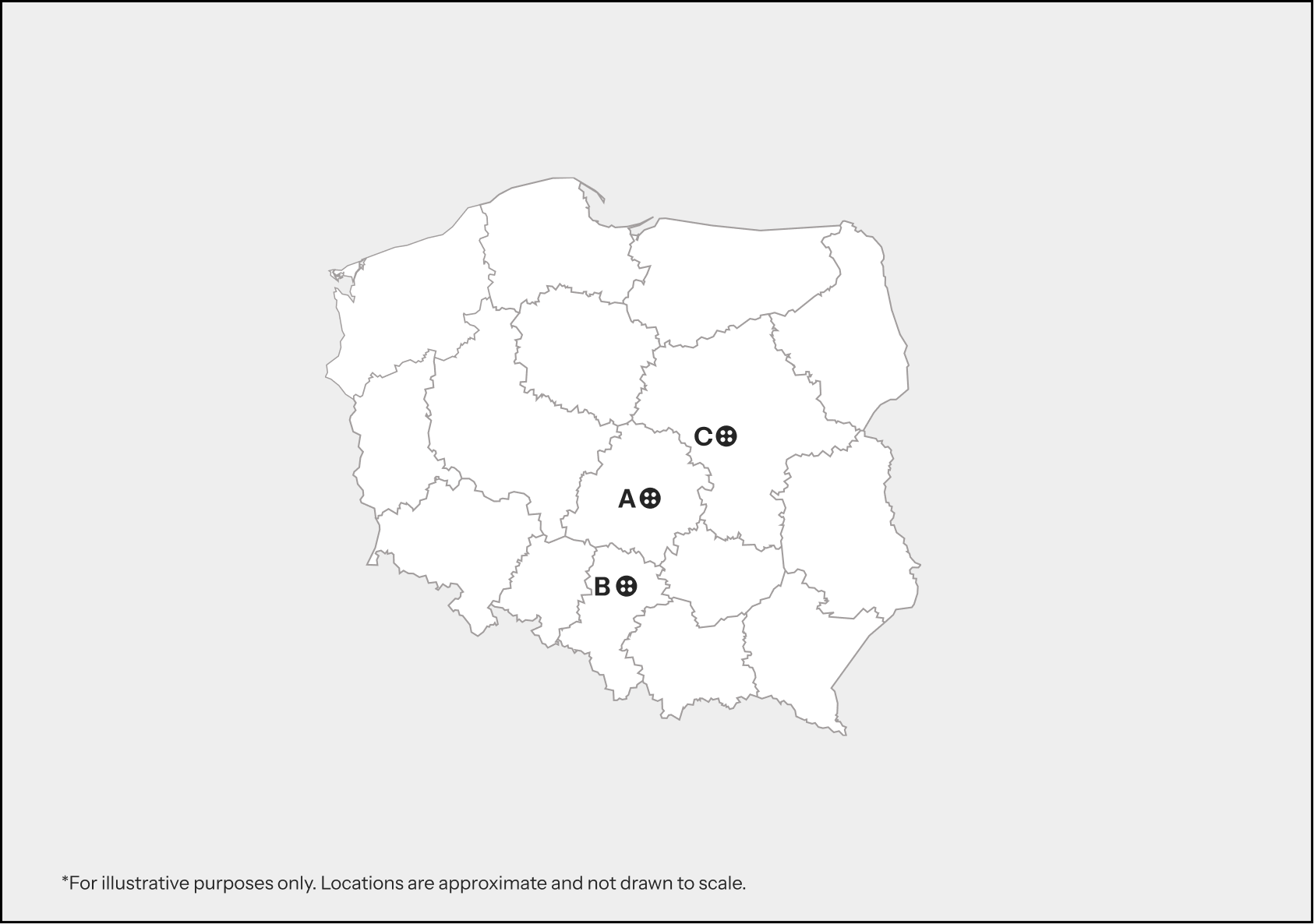Poland
download summary
Country Overview
No items found.
*All data is in tonnes per annum
TEXTILE WASTE*
2,116,000
Post consumer textile waste
1,036,840
Cotton
42.17%
Polyester
10.70%
Poly cotton
12.46%
Acrylic
4.79%
Viscose
4.31%
Wool
1.76%
Polyamide
1.28%
Other blends
19.33%
Other pure materials
0.80%
Unknown
2.40%
pre consumer textile waste
Post Industrial textile waste
Cotton
Polyester
Poly cotton
Acrylic
Viscose
Wool
Polyamide
Other blends
Other pure materials
Unknown
Imported textile waste
Cotton
Polyester
Poly cotton
Acrylic
Viscose
Wool
Polyamide
Other blends
Other pure materials
Unknown
*This data is collectively from Poland, Spain, Germany, UK, Netherlands & Belgium.
KEY POINTS ON Textiles & Apparels LANDSCAPE
€10.9B
Apparel Export (2023)
€12.51B
Apparel Import (2023)
Poland is the sixth-largest apparel exporter in Europe and the only Eastern European country among the EU’s top 10 importers . Unlike most EU countries, its sourcing from developing countries is growing, while others shift toward nearshoring. With rising exports and competitive labour and warehousing costs, Poland is emerging as a key regional distribution hub
$303M
Cotton Import
The country relies heavily on imports to meet its raw material needs due to very limited domestic cotton production, a dependence that has grown in recent years. To align with EU regulations and rising demand for eco-friendly textiles, it is increasingly channeling investments into sustainable materials such as organic cotton and recycled fibres.
70%
Poland's T&A industry is made of SMEs
SMEs make up majority of Poland’s textile and apparel industry, mostly private entities. The sector is split into 31% textile and 69% apparel producers, with textile production more concentrated and apparel more fragmented. Productivity is highest in textile spinning and lowest in apparel manufacturing reflecting greater investment in R&D and innovation in the earlier, more industrialized stages of production
300 kt/year
Sorting Capacity
Poland is a major export hub for sorting used & wasted textiles. It is one of the EU’s top receivers of waste textiles. Much of this material is re-exported. However, domestic reuse/recycling is low with Poland landfilling a large share of its collected textile waste
waste cost
waste Type
composition
price
notes
Post-Consumer
Cotton / Wool / Acrylic
€0.02–0.14 / kg
Feedstock for fibre-to-fibre recycling
production clusters
Key regions with fibre production
Dolnośląskie (A), Lubelskie (B), Kuyavian-Pomeranian (C), Lubusz (D), Wielkopolskie (E)

Key regions with apparel production:
Łódzkie (A), Śląskie (B), Mazowieckie (C)

Waste regulation
It is a comprehensive plan aiming to transform how textiles are designed, produced, consumed, and disposed of across the EU. It includes measures to make textiles durable, repairable, recyclable, and largely made of recycled fibers, while addressing overproduction, microplastic release, and greenwashing. The strategy sets the goal to achieve a sustainable and circular textile sector by 2030, aligned with the European Green Deal and Circular Economy Action Plan.
Strengthens waste management by mandating all EU member states to separately collect textile waste from January 1, 2025 and imposing Extended Producer Responsibility (EPR) schemes requiring producers to finance and organize the entire lifecycle management of their products’ waste. It emphasizes the waste hierarchy prioritizing prevention, preparing for reuse, recycling, recovery, and environmentally sound disposal, with clear definitions on when waste ceases to be waste (end-of-waste criteria)
Effective May 20, 2024, it tightens controls on waste shipments, including textiles, within and outside the EU. It bans most waste exports for disposal after May 21, 2026, requires audits, digital tracking, and enforces stricter penalties. The law supports the circular economy by ensuring environmentally safe waste management.
Effective July 18, 2024, it mandates durability, repairability, recyclability, and increased recycled content for textiles and most products. It requires Digital Product Passports, bans destruction of unsold textiles by large companies, and enforces life cycle environmental impact reduction. The regulation enables product-specific rules and harmonized penalties, driving a circular economy and sustainable production.
Waste trade
148.21 kT
Import quantities (HS 6309, 631010)
204.81 kT
Export quantities (HS 6309, 631010)
- The top exporters of used textiles to Poland in 2022 were Germany, the United Kingdom and the Netherlands
- The primary pathway for post-consumer textiles is re-export, followed by downcycling into industrial wipers for domestic and export use and lastly domestic SHC reuse and energy recovery through refused derived fuel (RDF)
green energy
15.2%
Share of modern renewables in final energy consumption
- Renewable Electricity Generation by source: Wind (62%), Solar PV (28.5%) & Hydro (9.6 %)
- Polish State aid instrument: It provides financial grants of 15–35% for large-scale low-carbon investments, supporting job creation and sustainable projects like renewable energy and green technologies. It targets strategic net-zero economy projects with aid available until the end of 2025, requiring beneficiaries to maintain investments and jobs for several years.
- PFR Green Hub: It is a strategic investment program by the Polish Development Fund that provides financial support to accelerate renewable energy projects and green technologies in Poland

